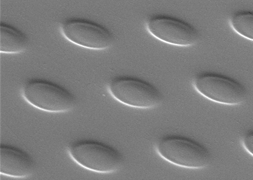
Glass as an alternative to silicon as a substrate material for interposer integration has been a hot topic at a number of industry conferences over the past few years. Glass manufacturers tout the benefits of glass—ultra-high resistivity and low electrical loss, low dielectric constant, and adjustable coefficient of thermal expansion, and low cost in panel format—while others caution that it exhibits higher impedance in the area of thermal management, and is outperformed by Si. Still, its potential for RF applications and passive interposers has been shown to be strong enough to take it seriously.
The adoption of this technology requires the development of interesting interconnect solutions that reduce the size of signal routing and, therefore, impose new demands on the dielectric materials used to isolate the copper interconnects.
At Dow, we determined that to perform lithography processes on glass panels, a dry-film photo-imageable laminate would prove to be a better approach than the spin- or spray-coating-solvent-based dielectric material due to the large surface area being coated. We selected benzocyclobutene (BCB) polymers as the basis for this laminate because they have been used to isolate copper interconnects in packaging applications for more than 20 years. Additionally, as BCB polymers were first developed at Dow, we have a deep understanding of the material properties and how to adapt them for different applications. For example, the BCB dielectric in question is too rigid to produce a high-quality laminate film, so we needed to modify the formulation to improve flexibility and lamination quality.
We presented a paper based on this work, “Photopatternable Laminate BCB Dielectric,” at IMAPS 2014. Read the article.